Pacific’s Cinerama Dome…Where Movie-going is an Event |
Read more at in70mm.com The 70mm Newsletter |
| Written by: John Sittig, Hollywood, USA. | Date: 01.01.2019 |
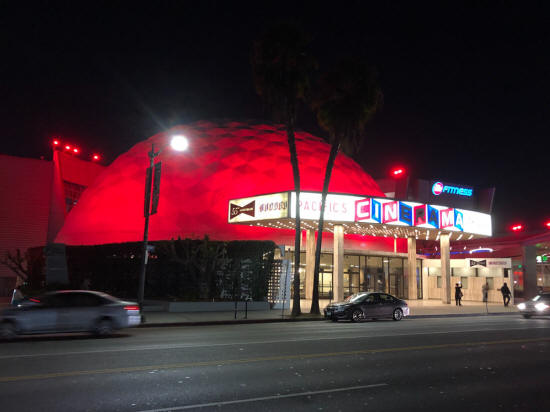 55th
anniversary of the Cinerama Dome, November 2018. Picture by Harrison Engle 55th
anniversary of the Cinerama Dome, November 2018. Picture by Harrison EngleThe first generation of Cinerama Theatres were converted movie palaces like the Warner Theatre in New York, The Music Hall in Detroit, The Palace in Chicago, The Empire in Paris and the Casino in London. Massive renovation costs were necessary to fit the giant curved Cinerama screen into the auditorium, removing the proscenium and side wall boxes, installing three booths on the ground floor, and reducing the seating capacity. In the 1950’s, there were less than 50 Cinerama theatres world-wide. (PDF: Cinerama Theatre List issue 18). • Go to Pacific’s Cinerama Dome Gallery By the end of the 1950’s the five Cinerama travel adventures had run their course and theatres reverted back to standard 35mm presentations. In 1959, Cinerama joined forces with Metro-Goldwyn-Mayer to produce 4 narrative, big budget roadshow films in the Cinerama process. Soon, other studios like United Artists, Warner Bros. and Paramount made similar production arrangements. For this new generation of Cinerama films, plans for new theatres were announced. Cinerama made a 10 year exclusive arrangement with Buckminister Fuller’s Geometrics Inc. to build 300 concrete domed theatres world-wide, as well as conventional 4 walled theatres to play Cinerama. These theatres would eliminate all the elaborate wall treatments of plaster and terra cota that distracted the audiences in the movie palaces. Instead, the four walls of the auditorium would be covered floor in ceiling with curtains and the screen would also be floor to ceiling and wall to wall. With the production costs and technical limitations, the 3 strip photographic process was abandoned after the productions, "WONDERFUL WORLD OR THE BROTHERS GRIMM" and "HOW THE WEST WAS WON". From then on, Cinerama films would be photographed in 65mm, single lens Ultra Panavision or Super Panavision and shown first on Cinerama screens in 70mm and 6 track magnetic stereophonic sound and then move on to flat screen 70mm theatres and eventually 35mm CinemaScope versions, neither of which would have a Cinerama title card nor any notice of Cinerama in the advertising. |
More in 70mm reading: Gallery: Pacific’s Cinerama Dome Interview with Mr John Sittig of Arclight - The Dome, Hollywood, Los Angeles Cinerama Dome's Fall Cinerama Roadshow Events Cinerama Dome (Los Angeles, USA) Celebrates Cinerama's 60th Anniversary The 55th Anniversary of Hollywood's Historic CINERAMA Dome Ladies and Gentlemen, This is Cinerama! in70mm.com's Cinerama page Internet link: |
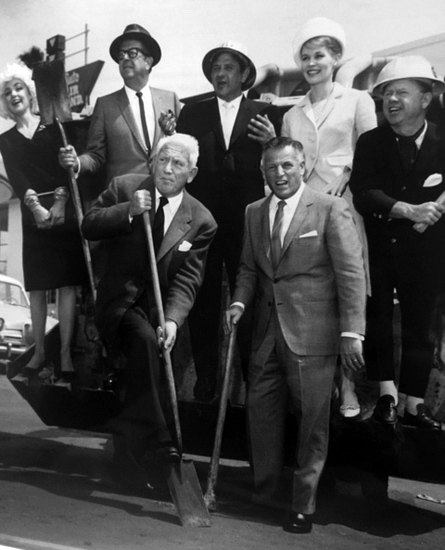 July
'63 announcement: Pacific’s Cinerama Theatre will open in 16 weeks, with the
world premiere of Stanley Kramer’s "IT’S A MAD, MAD, MAD, MAD WORLD".
Picture: John Sittig's collection July
'63 announcement: Pacific’s Cinerama Theatre will open in 16 weeks, with the
world premiere of Stanley Kramer’s "IT’S A MAD, MAD, MAD, MAD WORLD".
Picture: John Sittig's collectionIn July of 1963, the first of the 300 domed theatres was announced in Hollywood. It was announced that Pacific’s Cinerama Theatre, the first new theatre in 30 years would open in 16 weeks, with the world premiere of Stanley Kramer’s "IT’S A MAD, MAD, MAD, MAD WORLD". Kramer, cast members, theatre executives and United Artists representatives were all in attendance. The construction process was supposed to be very simple and cost effective. A regular 1000 seat four wall theatre would cost about $1,000,000 but a domed theatre would only cost about $750,000. The dome is made up of 316 steel reinforced concrete hexagons and pentagons in 17 different sizes and dimensions. After construction was complete, the 17 moulds would be moved to the next location. The final cost, working 7 days and overtime to finish on time for the premiere was $2.2 million dollars and the Cinerama Dome became “the only theatre of it’s kind in the world!”. The Cinerama Dome had a louvered screen measuring 30’ x 86’. The seating capacity was 959 on two sections, a slopped floor in front of the cross aisle and a stadium style loge section above the cross aisle. Seats were American Seating style #21-210, gold in color to match the floor to ceiling curtains. In the projection booth were three Norelco 35/70 AA projectors in the center section of the semi-circular booth and Ampex 6 channel magnetic sound system. The World Premiere of "IT’S A MAD, MAD, MAD, MAD WORLD" was November 7, 1963. It was covered live on the ABC Television network. All the biggest stars in Hollywood attended the premiere. "MAD WORLD" became the longest running engagement in the 55 year history of the Cinerama Dome playing 66 weeks. For the first 19 years, the Dome only played Los Angeles County exclusive engagements, meaning that if a film was playing at the Dome, no other theatre in Los Angeles County could play it. Only once the Dome engagement ended were other theatres able to show that particular film. Other long run films included THE GREATEST STORY EVER TOLD, 42 weeks, GRAND PRIX, 43 weeks, BATTLE OF THE BULGE, 27 weeks, CAMELOT, 51 weeks, ICE STATION ZEBRA, 27 weeks, PAINT YOUR WAGON, 35 weeks and SONG OF NORWAY, 35 weeks. In the non-roadshow era, DELIVERANCE played 18 weeks, ROLLERBALL, 19 weeks, THE WIZ, 20 weeks, WHO FRAMED RIOGER RABBIT, 19 weeks, and TERMINATOR 2, 14 weeks. |
|
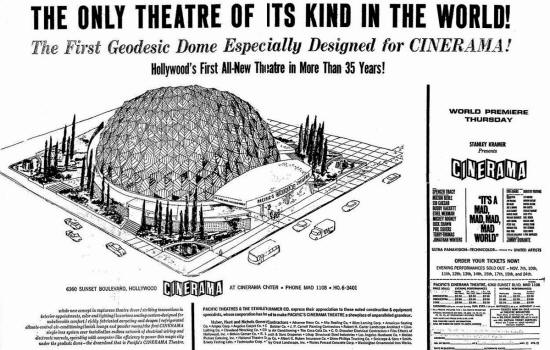 Newspaper
advert for the World Premiere of "IT’S A MAD, MAD, MAD, MAD WORLD", November
7, 1963. Advert from John Sittig's collection. Newspaper
advert for the World Premiere of "IT’S A MAD, MAD, MAD, MAD WORLD", November
7, 1963. Advert from John Sittig's collection.Click to see enlargement A film often associated with the Dome, "2001: A SPACE ODYSSEY" opened at the Warner Hollywood Cinerama and played 84 weeks before moving over to the Warner Beverly Hills for another 19 weeks. The Dome did not get "2001" until 1974 on a re-issue but has played it at least 20 times since including a 4 week 70mm engagement in 2018. In November of 1988, the Dome celebrated is 25th Anniversary with a two week celebration featuring over 40 films that played at the Dome. Opening film was "IT’S A MAD, MAD, MAD, MAD WORLD". We played Stanley Kramer’s personal 35mm 157 minute scope version of the film as the only print that United Artists had was a flat pan and scan version. Kramer, Jonathan Winters, and Stan Freberg among others were in attendance. Over the last 50+ years the Cinerama Dome has continually upgraded projection and sound to keep abreast of the latest innovations. In 1974, Dolby Type A CP 100 installed. 1975, Quintaphonic stereo of Ken Russell’s TOMMY, 1979, Dolby 6 track magnetic CP200 for APOCALYPSE NOW. 1986, Dolby Spectral Recording Dolby SR. 1991 CDS 70mm Digital Sound for TERMINATOR 2, 1992, Dolby Digital, SDDS Digital & DTS Digital. 2006, Christie Digital projection for THE DA VINCI CODE. X-PAND active 3D glasses for AVATAR, and now dual Christie dual 4K laser projectors. When the Cinerama Dome closed in 2000 for a major renovation and the construction of the adjacent ArcLight Cinemas three 1960’s vintage Century Cinerama projectors and sound reproducer were installed so that for the first time, we could play a real Cinerama film. The projectors came from the Consolidated Cinerama Theatre on Oahu. New 3 strip prints were made of "THIS IS CINERAMA" and "HOW THE WEST WAS WON". These 3 strip films play occasionally at The Dome. |
|
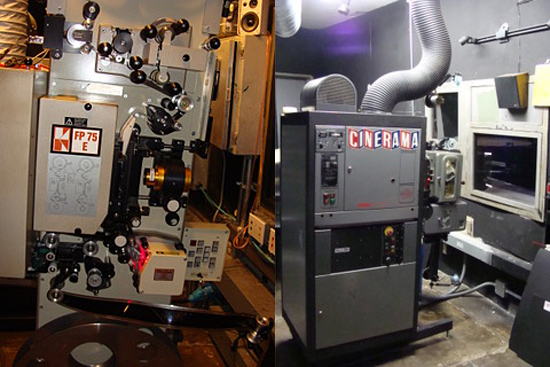 Modern
projection equipment. Philips/Kinoton FP75E and Cinerama. Pictures by John
Sittig. Modern
projection equipment. Philips/Kinoton FP75E and Cinerama. Pictures by John
Sittig.In 1996, a flat screen was placed in front of the curved Cinerama Screen and a black fabric ceiling was stretched over the audience to simulate a flat ceiling. This was done because director Alan Parker did not want his film EVITA played on the curved screen for the exclusive Los Angeles engagement. The flat screen was removed right after that engagement. In 2012, The Cinerama Dome held the 60th Anniversary of Cinerama Film Festival, “THE BIGGEST EVENT TO SOAR ACROSS THE CINERAMA SCREEN IN 60 YEARS". All of The 3 strip Cinerama titles were shown, either in 3 strip Cinerama or versions recently restored in 4K digital, plus "2001: A SPACE ODYSSEY" and "IT’S A MAD, MAD, MAD, MAD WORLD" in 70mm Ultra-Panavision 70. A new 28 minute 3 strip Cinerama short was shot in and around Los Angeles and had it’s World Premiere during the festival. People came from all over the world to see this once in a lifetime event. The Cinerama Dome has been home to many World Premieres, Sneak Previews, Research Screenings, Retrospectives, Film Festivals, and Promotional Events. Below are just a few examples. One very unusual event was the McDonald’s worldwide introduction of the ill-fated Arch DeLuxe sandwich, where the Dome was turned into a giant hamburger. For 55 years, The Pacific CINERAMA Theatre has been one of the most sought out venues from the Hollywood studios that want their film to premiere and play in the Dome. There have been complaints that the image is distorted because of the curved screen, but the people that count, the ones who have put down their money to see a film here have never complained. Outside of IMAX, it is one of the largest conventional theatre screens in the United States. The Cinerama Dome is also one of the most recognizable theatres in the world, and thanks to the 14 screen ArcLight Cinema complex behind it, is one of a handful of single screen theatres to survive in the 21st century. As our newspaper ads used to read… “Pacific’s Cinerama Dome…Where Movie-going is an Event”, and 55 years later, it still is. |
|
Cinerama Dome Construction Facts |
|
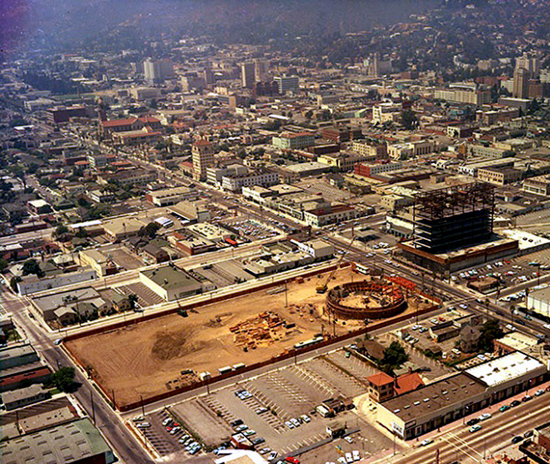 Rare
aerial view of the Cinerama Dome under construction
in the summer of 1963. The Dome is the circle in the top right corner of the
brown rectangle of property, at the corner of Sunset Blvd. and Ivar Ave. in
Hollywood. Picture: John Sittig's Collection Rare
aerial view of the Cinerama Dome under construction
in the summer of 1963. The Dome is the circle in the top right corner of the
brown rectangle of property, at the corner of Sunset Blvd. and Ivar Ave. in
Hollywood. Picture: John Sittig's CollectionDiameter of the Dome: 137 feet Height of the Dome: 69 feet Surface Area: 26,000 square feet Weight of the Dome: 525 tons Number of pre-cast panels: 316 Size of panels: 12’8” (maximum distance across panel) Minimum distance across panel: 9’6” Inner sphere radius of Dome: 70 feet |
|
Cinerama Dome Seating Facts |
|
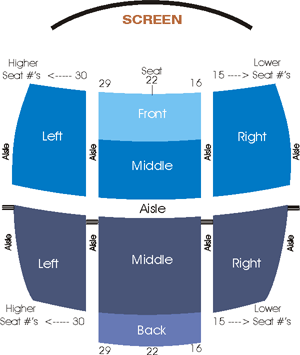 Original
number of seats: Original
number of seats:Lower Level: 490 Upper Level: 439 Total 929 *) Lower Level: Left Section: 147 Center Section: 196 Right Section: 147 Upper Level: Left Section: 122, Center Section: 195 Right Section: 123 *) Shortly after opening Upper Left and Right Sections added a Row Z of 11 seats each, and a Lower Left and Right Row A of 4 seats each bringing the total to 959. |
|
Cinerama Dome Screen Facts |
|
|
Full Screen (sheet) Size 73' W x 40' H Cinerama Screen 68'-8" W x 29'-6" H Chord 18' - 2 3/4" 70mm Screen 62' - 7"W x 29' - 6" H Chord 13' - 9 1/2" 35mm 1.85 53'W x 29' - 6" H Chord 9' - 3 1/2" 35mm 2.39 66' W X ? Chord 16' - 3 3/4" Picture lens to screen Throw 115' Digital Lens Konica Minolta 116.5mm DLP 2.5/45.2 - 68.0 mm 1.6-2.4:1(1.45-2.17:1 4K ) zoom HB |
|
Cinerama Dome 25th Anniversary, 1988 |
|
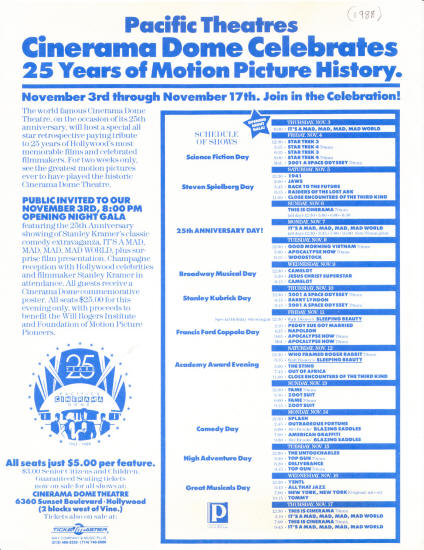 Cinerama Dome
25th Anniversary, 1988. This is how the original was, i.e. with this blue
ink. Wow, just look at that array of titles they did, and a good amount of
70mm! A souvenir of a bygone day. Cinerama Dome
25th Anniversary, 1988. This is how the original was, i.e. with this blue
ink. Wow, just look at that array of titles they did, and a good amount of
70mm! A souvenir of a bygone day.Paul Rayton's scan, February 2020 |
|
| Go: back - top - back issues - news index Updated 22-01-25 |
